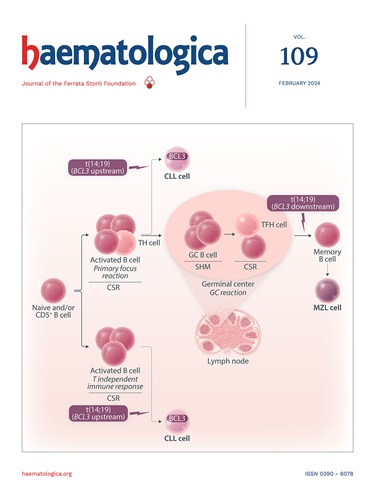RUNX1::RUNX1T1与CBFB::MYH11急性髓系白血病的临床特征和治疗决定因素不同。
IF 8.2
1区 医学
Q1 HEMATOLOGY
引用次数: 0
摘要
核心结合因子急性髓系白血病(CBF-AML)包括RUNX1::RUNX1T1和CBFB::MYH11 AML。为了研究它们是否应该被视为不同的实体并单独治疗,我们回顾性分析了536例60岁或以下的CBF-AML患者。对于CBFB::MYH11 AML,标准剂量(SD)和中剂量(ID)阿糖胞苷诱导之间没有观察到结果差异,5年总生存率(OS)和无复发生存率(RFS)分别为86.4%对85.3% (P=0.99)和74.1%对68.4% (P=0.93)。然而,ID诱导改善了RUNX1::RUNX1T1 AML的结果,5年OS和RFS率分别为77.7%和60.3% (P。本文章由计算机程序翻译,如有差异,请以英文原文为准。
Clinical characteristics and therapeutic determinants of RUNX1::RUNX1T1 differ from those of CBFB::MYH11 acute myeloid leukemia.
Core binding factor acute myeloid leukemia (CBF-AML) includes RUNX1::RUNX1T1 and CBFB::MYH11 AML. To investigate whether they should be regarded as distinct entities and treated separately, we retrospectively analyzed 536 patients with CBF-AML aged 60 years or younger. For CBFB::MYH11 AML, no outcome differences were observed between standard-dose (SD) and intermediate-dose (ID) cytarabine induction, with 5-year overall survival (OS) and relapse-free survival (RFS) at 86.4% vs. 85.3% (P=0.99) and 74.1% vs. 68.4% (P=0.93), respectively. However, ID induction improved the outcomes of RUNX1::RUNX1T1 AML, with 5-year OS and RFS rates of 77.7% vs. 60.3% (P.
求助全文
通过发布文献求助,成功后即可免费获取论文全文。
去求助
来源期刊

Haematologica
医学-血液学
CiteScore
14.10
自引率
2.00%
发文量
349
审稿时长
3-6 weeks
期刊介绍:
Haematologica is a journal that publishes articles within the broad field of hematology. It reports on novel findings in basic, clinical, and translational research.
Scope:
The scope of the journal includes reporting novel research results that:
Have a significant impact on understanding normal hematology or the development of hematological diseases.
Are likely to bring important changes to the diagnosis or treatment of hematological diseases.
 求助内容:
求助内容: 应助结果提醒方式:
应助结果提醒方式:


